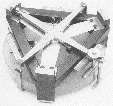 Left: The warping harness made by Arthur
Leonard to counteract astigmatism and coma on his off-axis Yolo
reflector. Mounted on the back of the secondary mirror, the harness is
adjusted to distort the optical surface suitably.
Left: The warping harness made by Arthur
Leonard to counteract astigmatism and coma on his off-axis Yolo
reflector. Mounted on the back of the secondary mirror, the harness is
adjusted to distort the optical surface suitably.
"Studies of the relative performances of various forms of reflecting and refracting telescopes have indicated that for lunar and planetary observing no obstruction should be present along the central part of the light path," said Arthur S. Leonard in his paper, " First-Order Tilt Aberrations in Mirrors and Lenses." This well known satellite observer and optical designer from Davis, California described ways in which tilted mirrors can be used to accomplish this. He exhibited one of his solutions - the "Yolo" reflector (named after the county in which he lives).
What a strange-looking telescope! From the upper end of the boxlike main body extends a three-foot-long tube. Inside this muffle are three light baffles. The eyepiece adapter tube juts out at about a 10-degree angle.
At the eyepiece end of the main body is an 8-inch spherical mirror of 192 inches focal length. Tilted 3° 04' from being perpendicular to the incoming starlight, this primary reflects the starlight to a 6-inch mirror of the same focal length. Mounted in a harness to warp its figure, the secondary reflects light back through the main body and out of the adapter tube.
But a telescope has to be field tested. How did the Yolo reflector work at the Friday night star party at Pyramid Lake? Even experienced observers saw familiar objects with a new crispness and contrast. As this 8-inch was turned from M11 to the Ring nebula to the Saturn nebula we waited eagerly - it was like one's first view all over again!
One of the last objects seen in the Yolo reflector was the Veil nebula in Cygnus. First one arch, then the other, was brought into the field of about one degree. In a fine sky, it was easy to see delicate wispy details in both - also folds and knots of brightness and outlying filaments.
As at Reno last year, we gave much attention to unobstructed reflectors. John Urban of the Eastbay Astronomical Society explained how theory predicts that optical designs should perform in the following order of merit: unobstructed reflector, apochromatic refractor, catadioptric, achromatic refractor, and obstructed reflector. If properly made, the first type of instrument should give virtually perfect images. Even the last will perform close to theoretical limits, though perhaps with reduced contrast on extended objects.
Davis amateur Arthur Leonard reviewed the problems of building his own 12-inch unobstructed reflector, called "Yolo" after his home county. In it both concave mirrors are tilted relative to the incoming light path. The second mirror is warped by a harness to compensate for the system's inherent astigmatism. Precise cancellation of the aberration poses the greatest obstacle to success.
When completed, the 12-inch Yolo will be installed in a sliding-roof observatory at the home of William Fisher, Sacramento Valley Astronomical Society, who reported on progress to date. The observatory will belong to the club.
Jack Borde of Diablo Valley described his backyard observatory with a 16-foot dome and a 10-inch Yolo. Despite its difficulties, this new type of instrument seems to be taking hold.
 Left: The warping harness made by Arthur
Leonard to counteract astigmatism and coma on his off-axis Yolo
reflector. Mounted on the back of the secondary mirror, the harness is
adjusted to distort the optical surface suitably.
Left: The warping harness made by Arthur
Leonard to counteract astigmatism and coma on his off-axis Yolo
reflector. Mounted on the back of the secondary mirror, the harness is
adjusted to distort the optical surface suitably.
The telescope is a 12½-inch f/17 unobstructed reflector of the Yolo design due to Arthur Leonard of Davis, California. In this off-axis system the secondary mirror is warped by a special harness to eliminate the aberrations introduced by tilting the mirrors. Only three instruments of this type have been constructed, this being the largest. Mr Leonard feels that larger sizes are very practical.
The chief advantage of the off-axis design is the absence of a central obstruction in the light path. This retains contrast, making delicate detail readily visible on planets, and the 204-inch focal length gives good scale.
The Yolo reflector, name for the county where Arthur Leonard lives north of San Francisco, has an even longer history of development. He showed an 8-inch at the 1965 Western Amateur Astronomers convention in Reno, Nevada.
A Yolo is a two-mirror unobstructed reflector, like a schiefspiegler except that the primary and secondary are both concave. For proper imaging under such conditions, at least the secondary, and in faster systems the primary as well, must have a figure that departs from a sphere by a few wavelengths here and there in a way that resembles certain potato chips. Dr. Leonard's idea is that the optical worker will simply make a good spherical mirror, then do the final "figuring" with a screw by observation of the stars.
The special cells and harnesses made by this retired professor of
mechanical engineering show excellent stability, holding the figure for
a year or more between adjustments. But so far all successful Yolos have
been rather slow, f/15 to f/18. He has recently shown mathematically that
a mirror with a square back will respond more faithfully to twisting and
will permit much faster Yolos in the future. Wooden models of the new
mirror blanks were displayed on the hood of his car.

Curator: Hartmut Frommert
[contact]
[Schiefspiegler Home]
[SEDS]